| Sanjay Gandhi National Park | |
|---|---|
| Borivali National Park | |
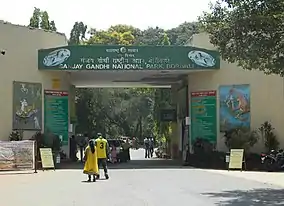 Main gate of the park | |
| Location | Mumbai, Maharastra, India |
| Coordinates | 19°15′N 72°55′E / 19.250°N 72.917°E |
| Area | 87 km2 (34 sq mi)[1] |
| Established | 1996 |
| Named for | Sanjay Gandhi |
| Visitors | 2 million (in 2004) |
| Governing body | Ministry of Environment, Forest and Climate Change[2] |
| Website | sgnp |
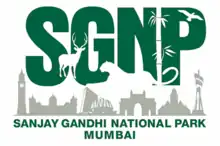
Sanjay Gandhi National Park (SGNP), is an 87 km2 (34 sq mi) protected area in Mumbai, Maharashtra. It was established in 1969 with its headquarters situated at Borivali.[1]
The 2400-year-old Kanheri caves, sculpted by monks out of the rocky basaltic cliffs, lie within the park. The rich flora and fauna of the Sanjay Gandhi National Park attract more than 2 million visitors every year.[3]
History
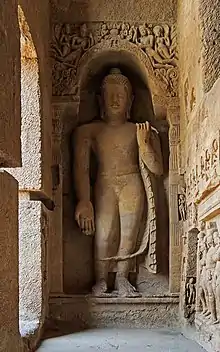
The Kanheri caves, located centrally in the park, were important Buddhist learning centres and pilgrimage sites sculpted by Buddhist monks between the 9th and the 1st centuries BCE.[4] They were chiselled out of a massive basaltic rock outcropping.[5] In 1996, the park was renamed to its current title, Sanjay Gandhi National Park, after Sanjay Gandhi. The same year, some forests from the Thane division were merged into the park, further expanding its total area to 103.84 km2 (40.09 sq mi).[6]
Geography
The park occupies most of the northern suburbs of Mumbai. To the west lie the suburbs of Goregaon, Malad, Kandivali, Borivali and Dahisar. To the east lie the suburbs of Bhandup and Mulund. To the south lies the Aarey Milk Colony and the university campus of IIT Bombay. The northern reaches of this forest lie in Thane city. The park and the areas surrounding it, except Thane city, are all part of Mumbai. It is the only protected forest located within the limits of a city.[7]
The region is hilly with elevations between 30 and 480 m (98 and 1,575 ft). The park has two lakes, Vihar Lake and Tulsi Lake, which meet a part of the city's water requirements. The park is said to be the lungs of the city as it purifies much of the air pollution in the city.
Biodiversity
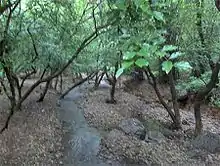

The park is forestland, with an estimated 800 types of mauve. This flower is native to the park and the surrounding regions, including Karnala, the Yeoor hills, Tungareshwar, and some parts of Goregaon's Film City. The park is also home to a small population of leopards.
Wildlife
This park is home to a number of endangered species of flora and fauna. The forest area of the park houses over 1,000 plant species, 251 species of migratory, land, and water birds, 5,000 species of insects, and 40 species of mammals. In addition, the park also provides shelter to 38 species of reptiles, 9 species of amphibians, 150 species of butterflies, and a large variety of fish.[8][9]
Flora
Kadamba, teak, karanj, shisham, and species of acacia, ziziphus, euphorbia, flame of the forest, red silk cotton tree, and a number of other varieties of flowers.
Mass flowering of karvi

The karvi (or karvy) shrub, as it is locally called in the Marathi language, only blooms once in eight years in a mass flowering covering the forest floor in a lavender blush. It grows in abundance in the Western Ghats hills near Mumbai and throughout the Sanjay Gandhi National Park as in other parts of its natural range. In the Sanjay Gandhi National Park, its last blooming occurred in 2016, and it is scheduled to bloom here again in late August-early October 2024. Termed by nature enthusiasts as 'nature's miracle,' the flowers are densest on some of the inner paths and trails that lie undisturbed in the park. It survives best on the vast sloping expanses of the hillsides, with the Kanheri caves area of the park being one of the best places to observe large areas of blooms.[10][11]
In the state of Maharashtra, the mass flowering of karvi has been observed to occur in Mumbai in the same year as in the hill station of Khandala and one year earlier in Bhimashankar and Malshej Ghat, beyond Kalyan.[12] Near Mumbai, the karvi is also found in Karnala, the Yeoor hills, Tungareshwar and some parts of Goregaon including Film City.[11]
Fauna

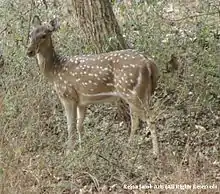
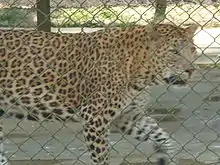
The forest cover in the park helps provide the ideal habitat for many wild animals. Chital (or spotted deer), rhesus macaque and bonnet macaque are some of the wild mammals often spotted inside the park. Other large mammals found in the park include black-naped or Indian hare, muntjac (barking deer), porcupine, Asian palm civet, chevrotain (mouse deer), Hanuman or grey langur, Indian flying fox, sambar deer and leopard.
Reptiles living here include crocodiles in the Tulsi Lake, pythons, cobras, monitor lizards, Russell's vipers, bamboo pit viper and Ceylonese cat snakes.[8]
In 2003, pugmarks and droppings of a Bengal tiger were found in the park. Although the tiger was never widely sighted, it did bring some excitement to city folks as records of tiger being found here are quite old and forgotten now with the last tiger being shot down 80 years earlier in the region.[13][14][15] Conservation was also proposed for the interlinked habitat corridors and nearby forest areas in the state along with upgrading their status as tiger habitat.[16]
A total 172 species of butterflies have been reported here, of which the spectacular ones are blue Mormon, the phenomenal artist of camouflage, blue oak leaf, bright Jezebel and large yellow and white orange tip, tiger butterfly, eggflies and sailers. There are a number of moths too. The largest moth is the size of a sparrow (30 cm).
Avifauna: Some of the birds found in the park are jungle owlets, golden orioles, racket-tailed drongos, minivets, magpies, robins, hornbills, bulbuls, sunbirds, peacock, and woodpeckers. Migratory and local birds such as the paradise flycatcher and various species of kingfishers, mynas, drongos, swifts, gulls, egrets, and herons have also been spotted.[8]>
Threats
The park has faced a number of problems similar to those faced by national parks elsewhere in the world, involving conflicts between natural and human interests.
In the early 2000s, a road, as proposed, would have cut through the park. Animal activist Tarun Nayar went to court to halt this project.
The lack of space in Mumbai has pushed residential colonies right up to the park boundary. This boundary is poorly fenced, and wild animals often wander into human habitations. Slums have mushroomed around the park as well. Corruption among local politicians and Mumbai's influential builder lobby are commonly seen as responsible for a perceived shrinking of the park.
In June 2004, leopards were responsible for the deaths of 20 humans within the span of a week. This was not the first attack: for the past 10 years, there have been attacks attributed to leopards stalking children and adults outside the park fringes. After an outcry was raised and the situation reached alarming proportions, eight leopards were caught and relocated.
The leopard threat still continues in and around the Thane district today, with repeated sightings as well as attacks on pets and humans. On 16 July 2012, a seven-year-old girl was killed in Mulund right outside her home by a leopard. A year later, a 40-year-old woman was attacked and killed by a leopard in Bhiwandi, Thane City, in 2013. Five days later, a 14-year-old shepherd survived a leopard attack in the same region.[17] In 2014, a two-year-old child went missing from Ghoong village in Wada.[18] August 2015 saw four leopard attacks in Thane city.[19] In one incident, a leopard and her cub dragged a one-year-old Rottweiler off.[20]
Fire
During the summer and any time before the monsoon, fires burn in the park, at least once every two weeks. This has resulted in the loss of rare trees and habitats for wild animals. The locals are often suspected of burning the trees on some of the outskirts of the forest to build homes there.
Tourism
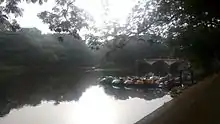
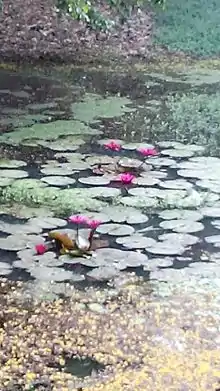
Sanjay Gandhi National Park is said to be one of the most visited national parks in Asia. According to estimates, around 2 million visitors visit this park annually. Collection at the gates in November 2004 touched ₹9.8 million (US$120,000).
The Krishnagiri Upavan is an area of approximately 5.5 km2 (2.12 sq mi) reserved as an easily accessible public recreation zone inside the park, while access to the remaining area is restricted. Among the several attractions of the Krishnagiri Upavan is a mini-zoo, a crocodile park, and the lion and tiger safaris through the natural habitats of these animals. A narrow-gauge train travels around the tourist zone, showcasing parts of the forest's rich biodiversity. Boating facilities such as two-person, pedal-powered boats are available for a nominal fee. Two watchtowers afford panoramic views of the park.

Hundreds of thousands of visitors travel to the Kanheri Caves, especially during festivals such as Maha Shivaratri. Nature trails and treks are also popular. Rock climbing enthusiasts often visit the national park as the numerous rock faces there and at the Kanheri Caves offer opportunities for rock climbers. There are many smaller parks within the national park with flower gardens, mini-waterfalls, resting spots, sunrise/sunset views, the occasional deer, and the misty boating lake.
Boating
Boating services are available near the Van Rani starting point with 2- and 4-seater pedalos for sailing in the small lake, which has a view bridge where visitors can stand and watch the boats in the water.
Local conservation NGOs such as the Bombay Natural History Society (BNHS)[11] and World Wildlife Fund for Nature-India (WWF-India)[12] bring groups of urban residents from Mumbai and elsewhere, sometimes in collaboration with other organisations, for regular guided nature education walks in the nature trails of Sanjay Gandhi National Park[21][22] and organise special trips when the rare karvi (Strobilanthes callosa) flowers are in full bloom which only happens once every eight years.[10]
Trimurti Temple
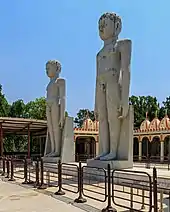
In the forest, there is a famous Jain temple called Trimurti (meaning "three idols") or Trimurti Digambar Jain Mandir. This temple is widely visited by Digambar sect of the Jain community. It has three huge idols of Lord Adinath and his two sons, Lord Bahubali and Lord Bharata. The statue of Rishabhanatha is 31 ft (9.4 m) in height and the tallest of all the three; on either side are the statues of Bharata and Bahubali, each being 28 ft (8.5 m). There is a 51 ft (16 m) kirti stambh (literally meaning "pillar of glory") also present here.[23]
Kanheri caves
Seven Buddhist caves older than the Kanheri Caves have been discovered very recently. Detailed exploration and documentation is awaited from The Archaeological Survey of India.[24]
References
- 1 2 Narkar, N.S.; Mhaiske, V.M.; Patil, V.K.; Narkhede, S.S.; Malave, D.B. (2017). "Socio-Economic Impact of Tourism Activity on Local Stakeholders of Sanjay Gandhi National Park, Borivali, Mumbai". Journal of Tree Sciences. 36 (2): 105−114. doi:10.5958/2455-7129.2017.00032.2.
- ↑ "Presentation".
- ↑ "2 million visitors of national park Borivali are unaware of this!". Bombay nagari. 2021. Retrieved 24 October 2021.
- ↑ "Kanheri Caves". Archived from the original on 12 May 2001. Retrieved 28 January 2007.
- ↑ "Mumbai's Ancient Kanheri Caves". Retrieved 31 January 2007.
- ↑ "Metro-3 row: 1,501 hectares of Aarey Milk Colony is part of the Borivali National Park in Mumbai, say experts". Hindustan Times. 20 February 2017. Retrieved 20 February 2017.
- ↑ "Mumbai's Sanjay Gandhi National Park: Essential Visitor's Guide". TripSavvy. Retrieved 12 June 2019.
- 1 2 3 "Sanjay Gandhi National Park, Borivali, Mumbai". Wildlife/National Parks. Maharashtra State Forest Department. Archived from the original on 10 February 2010. Retrieved 28 January 2010.
- ↑ Mirza, Zeeshan. & Pal, Saunak. (2008) A checklist of reptiles and amphibians of Sanjay Gandhi National Park, Mumbai, Maharashtra. Cobra, II (4), 14–19.
- 1 2 Nature lovers on the Karvy trail; TNN, 22 September 2008; The Times of India
- 1 2 3 City gears for lavender Karvi’s once-in-eight-years bloom Archived 17 August 2008 at the Wayback Machine; by Nitya Kaushik; 12 August 2008; The Indian Express Newspaper
- 1 2 The Karvy blooms; By Shantanu Chhaya; 24 July 2000; Bombay Edition: Bombay Times; The Times of India Supplement. A copy of this original Newspaper article is posted online at "mumbai-central.com": Archived 6 April 2010 at the Wayback Machine
- ↑ "Mumbai leaps into tiger territory".
- ↑ Livemint. "A tiger on Malabar Hill". livemint.com. Retrieved 18 March 2018.
- ↑ "The Hindu : Book Review : India's natural history".
- ↑ "Tiger may expand boundaries of park". Archived from the original on 3 January 2013. Retrieved 17 December 2009.
- ↑ "Teen injured in leopard attack in Thane". The Hindu. 31 July 2012. Retrieved 18 March 2018.
- ↑ "Leopard attack: 50 men search for 5 days but can t find 2-yr-old s body". mid-day.com. 1 September 2014. Retrieved 18 March 2018.
- ↑ "4 leopard attacks in 2 months leave Ovala residents on edge". The Times of India. Retrieved 18 March 2018.
- ↑ Mishra, Rashmi (12 August 2015). "Leopard Attack in Thane: Female Leopard & cub caught on CCTV snatching pet Rottweiler dog". india.com. Retrieved 18 March 2018.
- ↑ "Wet and Wild – Indian Express". indianexpress.com. 3 July 2009. Retrieved 18 March 2018.
- ↑ BNHS~ WWF to prevent garbage at Borivali park; 11 March 2002; Mid-Day
- ↑ "Shri Aacharya Shantisagar Smarak, Shri 1008 Aadinath Bahubali Digamber Jain Mandir Trust, Teenmurti, Podanpur,Mumbai Maharashtra". Archived from the original on 3 October 2016. Retrieved 23 July 2016.
- ↑ "Seven ancient Buddhist caves found in Mumbai". The Times of India. Bennett, Coleman & Co. Ltd. 17 January 2016. Retrieved 17 January 2016.
Sources
Parts of the article referred to from the Times of India article dated 5 July 2004
- Amol Patwardhan (2014) Butterflies of Sanjay Gandhi National Park, Mumbai, Maharashtra, India, Ambient Science, 1(1): 7–15.
- Sanjay Gandhi National Park: Flickr Group photos
Kasambe, R. (2012): Butterfly fauna of the Sanjay Gandhi National Park and Mumbai. Bionotes. 14 (3): 76–80
External links
- Official website
- SGNP link on Maharashtra FD Website of "Sanjay Gandhi National Park Borivali, Mumbai 400066".
- A detailed Review of Kanheri Caves and : Read this before you go.